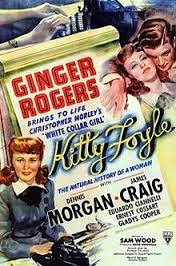One reason might be that she spent years as a brunette and did not find much success until portraying the obsessed, self-destructive blonde in Written on the Wind. Her performance resulted an Academy Award for Best Supporting Actress. No wonder she kept her new platinum tresses! The case seems pretty cut and dry, but I can't help but wonder if there is something more at play here.
Dorothy Malone is not the only actress of note who began their career with a hair color other than the one by which they are now defined. Remember that definitive red head, Lucille Ball?
How about Paulette Goddard?
Eleanor Parker anyone?
These women had star quality without the dye, so why change the color? As I contemplate the question, I find myself drawn to Kitty Foyle, the movie in which Ginger Rogers famously traded in her blond locks in favor of a darker shade.
Kitty Foyle is the story of a working-class girl who falls in love with an upper-class boy. They marry, but due to their different stations in life, the union is ultimately doomed and the marriage is annulled. In her autobiography, Ginger: My Story, Ginger Rogers writes, "After I had digested the script, I concluded that Kitty couldn't possibly be a blonde. She was the daughter of a proud Irishman, and had to look and act like one. Dark hair, blue eyes, a quick wit, and a stinging tongue" (269).
Hmmm....could Ginger be alluding to a hair color stereotype that was present in Hollywood? Just as the white horse indicated the hero while the black signaled the villain, could hair color tell the movie goer what kind of woman was beneath the tresses?
Maybe actresses who wanted to change the type of roles they were being offered--or big studio bosses who wanted to fulfill a type that was lacking on the payroll--resorted to dye. Working woman? Brunette. Dizzy dame? Blonde. Good girl? Brunette. Obsessed, self-destructive floozy? Blonde. The implication of such typing is alarming when societal attitudes are at stake. (Could this be where blonde jokes originated? Think Marilyn Monroe and Jayne Mansfield.)
It's a theory worth exploring.
Rogers, Ginger. Ginger: My Story. New York: HarperCollins, 1991.





No comments:
Post a Comment
Note: Only a member of this blog may post a comment.